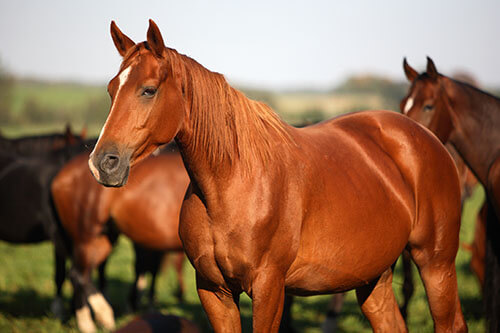Including Roasted Soybeans in Equine Rations
Dec 16, 2019

The equine digestive system is designed to break down forage through fermentation in the hindgut, potentially supplying as much as 70% of their daily energy requirement. It is well known that exercised, nursing or under-weight equines must be supplemented with protein/energy-dense feedstuffs that are easily digested to meet higher requirements not met with hay &/or pasture alone. Feed intake, growth, physical activity, physical endurance, condition, milk production & fetal development can be impaired if protein intake is inadequate or of poor quality. Protein quality is essential since it is the building block to create the following body protein:
Soybean by-products have always been the most highly acceptable feedstuffs but rarely have whole soybeans been utilized in horse diets. Soybeans are already a natural & important source of protein, vitamins, minerals & high energy oils in many animal feeds. It is extremely important to point out that roasting soybeans prior to feeding horses is absolutely required. The roasting process destroys unwanted urease enzymes & trypsin inhibitors which prevent protein digestion in the small intestine. At the same time, roasting makes protein, fat & amino acid of the soybean easier to digest. The high biologic protein value of roasted soybeans is a beneficial complement of lysine to typical forage proteins available to horses in Tennessee. Additionally, roasted soybeans are a high fat ingredient that provides digestible fatty acids, specifically omega 6 & precursors of omega 3. Beginning in March, Tennessee Farmers Cooperative will be including roasted soybeans in several Pinnacle Horse Feeds.
A final point about protein: Increased protein quality of the diet is not generally responsible for a “hot” horse. From a metabolic standpoint, protein is a very inefficient energy source, & its main use in the mature horse is re-building of muscle & body tissue & cells after exercise. Alternatively, it is starch & sugar in the diet. Evaluate calorie intake: calorie used (exercise level) ratio. Since protein utilization as an energy source is poor, faster absorbing energy sources are the primary culprit.
- Heart, liver, lungs & other vital organs
- Bone & Skeletal muscle
- Skin, hair, & hooves
- Eyes
- Connective tissue
- Enzymes
- Antibodies, white/red blood cells
Soybean by-products have always been the most highly acceptable feedstuffs but rarely have whole soybeans been utilized in horse diets. Soybeans are already a natural & important source of protein, vitamins, minerals & high energy oils in many animal feeds. It is extremely important to point out that roasting soybeans prior to feeding horses is absolutely required. The roasting process destroys unwanted urease enzymes & trypsin inhibitors which prevent protein digestion in the small intestine. At the same time, roasting makes protein, fat & amino acid of the soybean easier to digest. The high biologic protein value of roasted soybeans is a beneficial complement of lysine to typical forage proteins available to horses in Tennessee. Additionally, roasted soybeans are a high fat ingredient that provides digestible fatty acids, specifically omega 6 & precursors of omega 3. Beginning in March, Tennessee Farmers Cooperative will be including roasted soybeans in several Pinnacle Horse Feeds.
A final point about protein: Increased protein quality of the diet is not generally responsible for a “hot” horse. From a metabolic standpoint, protein is a very inefficient energy source, & its main use in the mature horse is re-building of muscle & body tissue & cells after exercise. Alternatively, it is starch & sugar in the diet. Evaluate calorie intake: calorie used (exercise level) ratio. Since protein utilization as an energy source is poor, faster absorbing energy sources are the primary culprit.